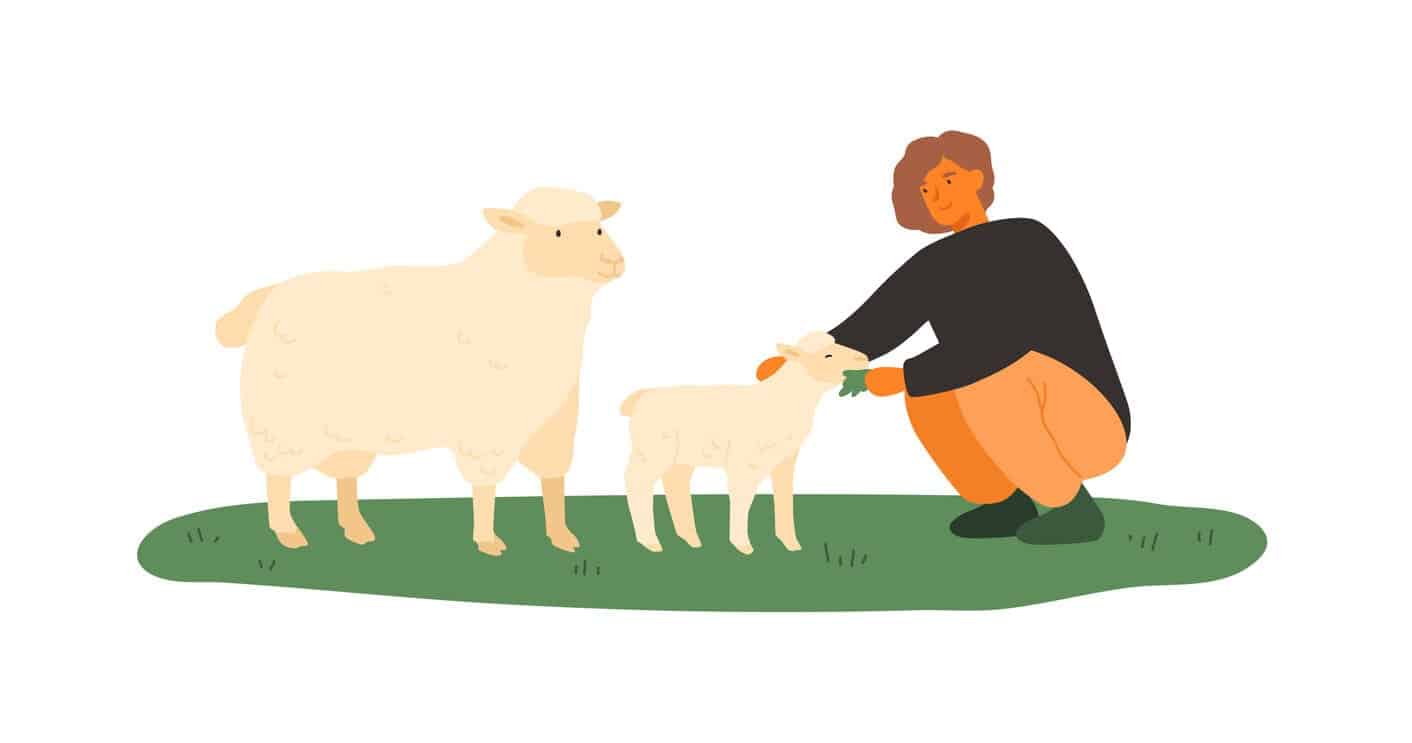Knowing the classification of animals is not a must-know list, so not knowing the difference between a lamb and a sheep is common. We just don`t pay attention to those details, and sometimes we mix up the sheep and a lamb. We will learn what defines them, and then it will be easier to learn what separates them.
So, you find yourself in the talk about meat or an animal, and you are not sure what term to use – sheep or a lamb? The first and the most important difference is age. Lambs are sheep younger than one year. When a lamb grows up it becomes a sheep.
Difference Between Lamb And Sheep
That age difference results in all the other differences, and we will name a couple here before we go into the deeper analysis:
- If a lamb is planned for slaughter and meat, its tail is shortened in a process named docking. It is done to prevent blowfly strike, a type of parasitic infection that can lead to slowed growth of the lamb.
- Sheep leather is sturdy and used for making leather accessories and in the furniture industry. Lamb leather is softer and it is used in the clothing industry, usually in making coats, jackets, dresses, pants, and similar wardrobes.
- Lamb manages to weigh between 5 and 30 kilos, compared to a sheep’s weight that can vary between 30 and 100 kilos.
These are just some basic physical differences, but there are a lot more that can be pointed out as a difference between a lamb and a sheep. We will point out some interesting facts about these animals, and answer some of the FAQs about them. Stay with us!
Facts About Sheep And Lamb
We covered the basic differences between them, but to go any further, we need to cover the basics of both sheep and lamb.
When the domestication of animals started, one of the first animals that were domesticated was sheep. Sheep proved to be a great addition to a human homestead because it has many uses.
Sheep provides some of the essential needs as meat and milk with their great nutrition value, and wool which is used for making clothes for harsher and colder conditions.
Until wool humans had a real hard time keeping themselves warm during winter, so sheep was a part of resolving this big problem.
Another great thing about sheep is the natural flock behavior that makes them easier to control when compared to other flock and herd animal species.
Sheep that were used for milk and wool production are sold out for mutton meat when they stop being profitable. The natural life span of a sheep is between 12 and 14 years.
As we said, sheep that are younger than a year are called lambs. Sheep farmers that focus on the production of meat, in most cases young lambs prepare for that purpose early on.
They have their tail stocked, to prevent several diseases and hygiene problems. They are also sterilized because that raises the quality of the meat and brings a higher price.
Lambs raised for meat are slaughtered between 4 and 12 months. Lamb meat is considered a specialty in many cultures around the world.
| Lamb | Sheep |
| Sheep are considered lamb up to 12 months of life | Sheep can live up to 14 years |
| Lamb is primarily used for meat | Sheep are used for wool, milk, and meat |
| Lamb is fed with milk | Sheep eats grass |
FAQ About Sheep And A Lamb
Why do we eat lamb and not sheep?
Actually, we eat both, but lamb meat is preferable for a couple of reasons. First is the age factor – lamb meat is younger. Other factors that recommend using lamb are its tenderness, lower fat levels, and can be easier cooked. If you are looking for a great meal for your family, you should go for a lamb, but if you want a meal with more flavor and with more meat then sheep mutton could be a better choice.
Is lamb a goat or a sheep?
Lamb is a young sheep. A goat is a domesticated animal from a wild goat that is a part of a goat-antelope animal family.
Does a lamb become a sheep?
Yes, it does. A lamb is just a name for a young sheep. A lamb becomes sheep after it becomes older than one year.
What is the difference between a lamb, a sheep, and a goat?
Lamb and sheep are the same animals, just of different age groups. Goats and sheep are different animals but are still closely related.
What animal was first to be domesticated, sheep or a goat?
Sheep were domesticated before goats, around 11000 B. C. while goats were domesticated 500 to 1000 years later.
History of Animal Domestication, And Why Sheep Were First
When people turned from hunting to domestication, there were a lot of issues to cover. They needed to cover all their needs, from food to shelter and clothing. If they wanted to fulfill all their needs, several animals were needed to be domesticated. The timeline of domestication was:
- Sheep around 11000 years B. C.
- Goat 10500 – 10000 years B. C.
- Cow and pig 10300 – 10000 years B. C.
- Horse – 5500 years B. C.
- Chicken – 4000 years B. C.
- Turkey – 2000 years B. C.
- Duck – 1000 years B. C.
All these animals were domesticated on the territory of the Middle East, and Central and Southern Asia, besides the duck, which home was North America.
One of the reasons why sheep were among the first animals to be domesticated is because they are easy to keep in the herd.
That is their natural way of life, so all the early shepherds needed to learn is how sheep move and live, and then it was easy to adapt them to living beside humans.
Another reason for early sheep domestication is the lot of benefits they bring to human life. Sheep meat is a great source of protein and many minerals and vitamins, it is tasty, and can be cooked in a lot of ways.
Sheep also produces milk that can be turned into different dairy products. Sheep provides not only food but also wool that is used for making clothes with different attributes than their leather cloth alternatives. It kept people warm and protected from harsh weather conditions.
Sheep is an animal with so many uses, that it is not hard to see its high value. When compared to other domesticated animals it can be seen why sheep are among the first domesticated animals.
Living without domesticated sheep would make a life for humans a lot different and harder for sure. Finding alternatives for all their practical use is virtually impossible, without losing on the quality of the end product.
From this article you could not only learn about the difference between the sheep and their young state – the lamb, but also cover the topic of the history of animal domestication, and why sheep is so important to us. After learning all these things we hope that everyone will treat sheep with little more respect because they surely deserve it.



